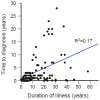How long does it take to diagnose cervical dystonia?
- PMID: 24034410
- PMCID: PMC3840082
- DOI: 10.1016/j.jns.2013.08.028
How long does it take to diagnose cervical dystonia?
Abstract
Background: Dystonia is a neurological disorder characterized by involuntary twisting movements and postures. The neck is among the most commonly affected regions, and diagnosis can be made readily through a simple clinical evaluation. The goal of this study was to explore how long it took patients to receive a diagnosis of cervical dystonia after symptom onset.
Methods: A structured questionnaire was administered at outpatient clinics of a tertiary care academic medical center to 146 consecutively evaluated patients. The questionnaire addressed the length of time from symptom onset to diagnosis, the numbers and types of providers seen before reaching a diagnosis, and treatments attempted prior to receiving botulinum toxin.
Results: A total of 108 patients saw a mean of 3.5 providers over a mean period of 44 months from symptom onset to diagnosis. For patients with symptom onset in the last decade only, patients saw a mean of 3.0 providers over a mean of 14 months.
Conclusions: Although cervical dystonia is the most common form of dystonia with clinical features readily identifiable by a simple history and examination, patients typically see multiple providers over more than a year before reaching a diagnosis and receiving optimal therapy. Improved awareness of the clinical features will enable patients to obtain appropriate therapy more rapidly.
Keywords: Cervical dystonia; Cohort studies; Diagnosis; Dystonia; Movement disorder; Torticollis.
© 2013.
Figures


References
-
- Slawek J, Friedman A, Potulska A, Krystkowiak P, Gervais C, Banach M, et al. Factors affecting the health-related quality of life of patients with cervical dystonia and the impact of botulinum toxin type A injections. Funct Neurol. 2007;22:95–100. - PubMed
-
- Evatt ML, Freeman A, Factor S. Adult-onset dystonia. Handb Clin Neurol. 2011;100:481–511. - PubMed
-
- Simpson DM, Blitzer A, Brashear A, Comella C, Dubinsky R, Hallett M, et al. Assessment: Botulinum neurotoxin for the treatment of movement disorders (an evidence-based review): report of the Therapeutics and Technology Assessment Subcommittee of the American Academy of Neurology. Neurology. 2008;70:1699–706. - PMC - PubMed
Publication types
MeSH terms
Substances
Grants and funding
LinkOut - more resources
Full Text Sources
Other Literature Sources
Medical

